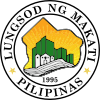Singkamas, Makati
Singkamas is a barangay located in Makati, Metro Manila, Philippines.[2] It is a predominantly residential area with a population of 7,218 recorded by the 2020 census. It is the second smallest barangay in Makati in terms of land area with a land area of 12.59 hectares (31.1 acres).
Etymology
The name of the barangay derived from the word singkamas, a local term for jicamas, which was involved in the then-barrio's past unique tradition wherein it is hanged while it was fresh and succulent instead of the usual buntings during their fiesta.
History
Singkamas was previously a sitio part of Barrio Tejeros. It had about 200 houses of light materials and 150 houses of stronger built. The first move towards this independent status was taken in the early 1950s when the residents felt it would be more beneficial for them to have their own set of leaders and the autonomy to manage their own affairs especially its Barrio Fiesta.
In 1960, after the passage of Republic Act No. 2370 (Barrio Charter), Barangay Singkamas was officially recognized as a separate barrio from Barrio Tejeros. Inspired by their independent status, the inhabitants built their own house of worship — the Holy Cross Chapel — which became the rallying point of neighborhood rehabilitation. This landmark also became the center of public forum and festivities, like Christmas and Barrio Fiesta Celebrations. Being the second smallest barangay of Makati, Barangay Singkamas struggled to sustain its existence by depending on its sparse income or revenue derived from tax collections, individual retirement accounts (IRA) and real property tax (RPT) entitlements.
References
- ^ Census of Population (2020). Table B - Population and Annual Growth Rates by Province, City, and Municipality - By Region. Philippine Statistics Authority. Retrieved 8 July 2021.
- ^ "Barangay Singkamas". Makati Web Portal. Retrieved April 15, 2023.
- v
- t
- e

- Bangkal
- Bel-Air
- Carmona
- Dasmariñas
- Forbes Park
- Guadalupe Nuevo
- Guadalupe Viejo
- Kasilawan
- La Paz
- Magallanes
- Olympia
- Palanan
- Pinagkaisahan
- Pio del Pilar
- Poblacion
- San Antonio
- San Isidro
- San Lorenzo
- Santa Cruz
- Singkamas
- Tejeros
- Urdaneta
- Valenzuela
- Legislative Districts
- Commercial Districts
This article about a location in Metropolitan Manila (NCR) is a stub. You can help Wikipedia by expanding it. |
- v
- t
- e











